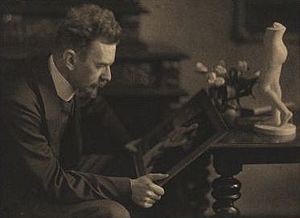Heinrich Wölfflin facts for kids
Quick facts for kids
Heinrich Wölfflin
|
|
|---|---|

Photograph by Rudolf Dührkoop
|
|
| Born | 21 June 1864 Winterthur, Switzerland
|
| Died | 19 July 1945 (aged 81) Zurich, Switzerland
|
| Burial place | Basel, Switzerland |
| Alma mater | University of Munich |
| Occupation | Art historian |
| Parent(s) |
|
Heinrich Wölfflin (born June 21, 1864 – died July 19, 1945) was a Swiss art historian and teacher. He created clear ways to describe art, like comparing "painterly" (like a painting) to "linear" (like a drawing). These ideas were very important for how art history was studied in the early 1900s.
Wölfflin taught at important universities in Europe. He helped make German art history famous. His three main books are still used today: Renaissance und Barock (1888), Die Klassische Kunst (1898, "Classic Art"), and Kunstgeschichtliche Grundbegriffe (1915, "Principles of Art History").
He taught at Berlin University from 1901 to 1912. Then he moved to Munich University from 1912 to 1924. Finally, he taught at Zurich University from 1924 until he retired.
Early Life and Education
Heinrich Wölfflin was born in Winterthur, Switzerland. He is buried in Basel. His father, Eduard Wölfflin, was a professor who studied old languages. His father also helped start a huge Latin dictionary called the Thesaurus Linguae Latinae.
Heinrich Wölfflin studied art history and history at the University of Basel. He learned from Jakob Burckhardt, a famous historian. He also studied philosophy at Berlin University and University of Munich. He earned his degree in philosophy from Munich University in 1886. Even then, he was already focused on art history, which was a very new field of study.
His main philosophy teacher at the University of Munich was Heinrich Brunn, a well-known archaeology professor. Wölfflin was greatly influenced by his teachers. His doctoral paper, Prolegomena zu einer Psychologie der Architektur (1886), showed his unique way of looking at art. He analyzed art forms by thinking about how artists create them. This paper is now seen as one of the first important writings in art history. However, it was not widely noticed when it was first published.
Career and Teaching
After finishing his studies in 1886, Wölfflin traveled and studied in Italy for a year. He then published his book Renaissance und Barock (1888). This book showed his approach to understanding art. He continued to use his methods in other books about the Renaissance and Baroque periods.
Wölfflin saw the art style called "Mannerism" (from the 1500s) as part of the Baroque style. Before him, many scholars thought Mannerism was not good art. When Jakob Burckhardt died in 1897, Wölfflin took over his art history teaching job at Basel.
Wölfflin is known for using two projectors side-by-side in his art history lectures. This allowed him to compare two images at the same time. This was a new idea when old "magic lanterns" were still used. Famous art historians like Sir Ernst Gombrich and Erwin Panofsky said Wölfflin inspired them. One of Wölfflin's notable students was Klara Steinweg.
Principles of Art History
In his book Principles of Art History, Wölfflin described five main ways that art changed between the 1500s and 1600s. He showed how artists started to see things differently. These five pairs of ideas were:
- From linear to painterly:
- Linear art focuses on clear outlines and shapes, like a drawing.
- Painterly art focuses on colors, light, and shadows, blending them together. It's more about how things look with light, not just their edges.
- From plane to recession:
- Plane art arranges things in flat layers, like a stage set.
- Recession art makes you feel like you are looking deep into the picture, with things moving forward and backward.
- From closed (tectonic) form to open (a-tectonic) form:
- Closed art feels complete and contained within its frame. It often uses strong vertical and horizontal lines.
- Open art feels like it reaches out beyond the edges of the picture. It uses more diagonal lines and movement.
- From multiplicity to unity:
- Multiplicity art shows many separate parts, each important on its own.
- Unity art makes all the parts work together to create one strong overall feeling. The details are less important than the whole picture.
- From absolute clarity to relative clarity:
- Absolute clarity art shows every detail clearly.
- Relative clarity art might not show every detail perfectly. Instead, it uses light and shadow to create a certain mood or feeling, even if some parts are less clear.
Wölfflin followed in the footsteps of earlier art historians like Giorgio Vasari. He created a way to understand how art styles changed over time. He used this method to study art from the 1300s, 1400s, and 1500s in his book Classic Art (1899). He then developed it further in The Principles of Art History (1915). Wölfflin's Principles of Art History has become very important again for art historians and people who study the ideas behind art. In 2015, The Journal of Aesthetics and Art Criticism published a special issue to celebrate 100 years since the book was first published.
Works
- H. Wölfflin. Principles of Art History. The Problem of the Development of Style in Later Art, translated by M D Hottinger (Dover Publications, New York 1932).
- H. Wöllflin. Classic Art. An Introduction to the Italian Renaissance. Translated by Peter and Linda Murray (Phaidon Press, London 1952).
- H. Wölfflin. Die Kunst Albrecht Dürers (The Art of Albrecht Dürer), (F Bruckmann, Munich 1905).
- H. Wölfflin. Die Bamburger Apokalypse: Eine Reichenauer Bilderhandschrift vom Jahre 1000 (The Bamburg Apocalypse: A Reichenau illuminated manuscript from the year 1000), (Kurt Wolff, Munich 1921).
- H. Wölfflin. Italien und das deutsche Formgefühl (Italy and the German sense of Form), (1931).
- H. Wölfflin. Gedenken zur Kunstgeschichte (Thoughts on Art History), (1941).
- H. Wöllflin. Kleine Schriften (Shorter Writings), (1946).
See also
In Spanish: Heinrich Wölfflin para niños

